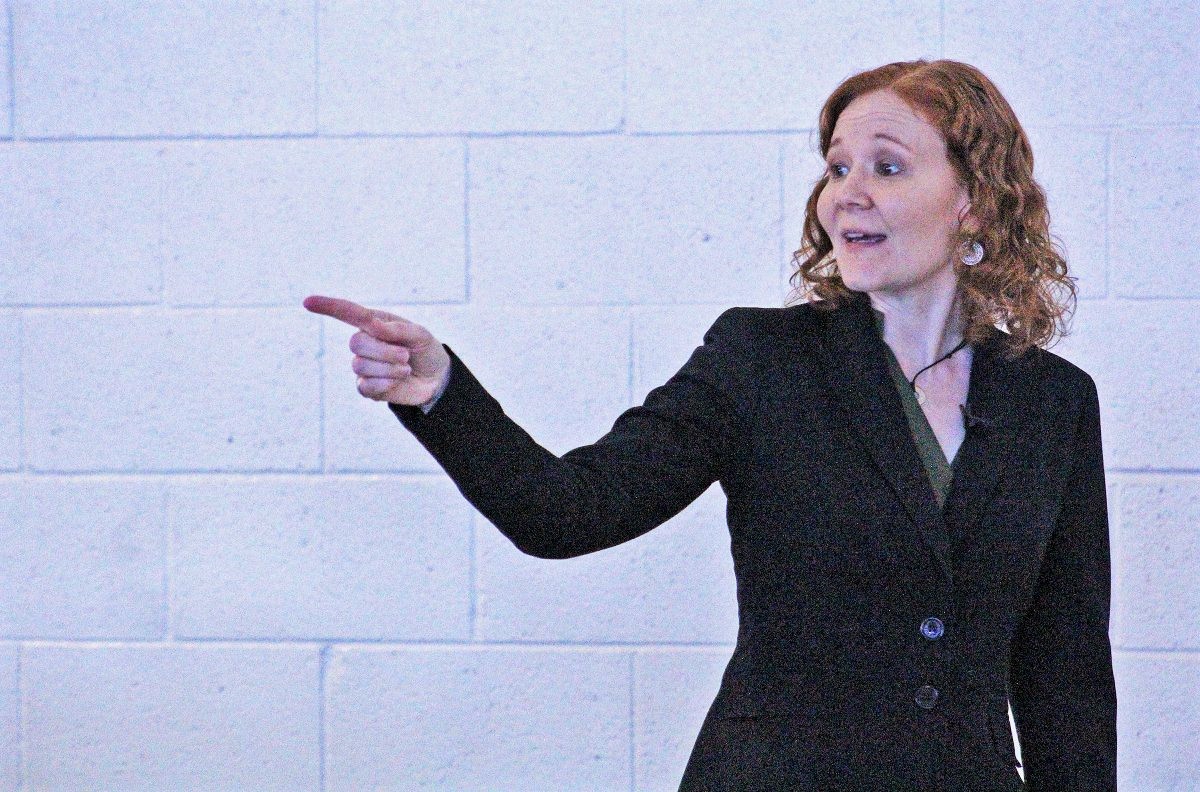(Editor’s note: Heather Bowlds, deputy director of DJJ, lectured on the development of the adolescent brain. This story was published Feb. 15, 2017.)
Harsh light from the afternoon sun flooded through tall windows at the Valley State Prison (VSP) gymnasium and starkly illuminated the lanky frame of Parker Chamberlin, who stood microphone in hand — heart on sleeve.
Chamberlin addressed psychologist Dr. Heather Bowlds, the deputy director of the Division of Juvenile Justice (DJJ), who gave her final lesson on the development of the adolescent brain Jan. 25.
Bowlds’ lecture and accompanying videos made a real impact on Chamberlin, who is serving a life sentence at VSP for a crime he committed as a juvenile. Chamberlin is now a facilitator for incarcerated youth in DJJ’s Youthful Offender Program (YOP).
The YOP delegates a special classification committee to review cases of youth transferring to the adult system and, based on the youth’s merits, place him in a lower-security prison yard. The goal is to keep youth away from more serious and violent criminal influences found at high-security level prisons.
Chamberlin, also a YOP mentor, keenly listened as Bowlds discussed the impact of trauma on the adolescent brain, recognizing the parallel’s in his own path to incarceration.
“I saw a lot of myself, or at least of my younger self, in some of the things she shared regarding trauma,” Chamberlin said after the lesson. “Like how childhood experiences can affect the development of the brain.”
The presentation was enlightening.
“My dad was addicted to drugs and he overdosed and died when I was 7 years old,” Chamberlin added. “I now know how that affected how I thought about the world and how I interacted with other people, especially authority figures.
“That doesn’t excuse, but it explains to some extent why I behaved the way I did when I was young.”
Bowlds has been the associate director of mental health for DJJ since 2014. Her talk on the development of the adolescent brain has pioneered vital training and procedure changes for CDCR staff and YOP mentors. It’s a big reason why she was named the 2016 DJJ Professional of the Year by CDCR and appointed DJJ deputy director by Gov. Jerry Brown in October.
Her new position demands a different schedule, so the Jan. 25 lesson at VSP served as her encore appearance, recorded by CDCR for future training and discussion. She spoke to around 50 incarcerated people and 45 members of VSP custody staff for about three hours.
“In 23 years, I have never seen a place where staff and (the incarcerated population) train together,” YOP Capt. Mike Masters said. “Even 10 to 15 years ago, staff would have never trained with (the population). It shows where we are headed now.
“Everybody is on the same page, realizing we have to treat youth a little differently, and we are all really excited about making this program work.”
Bowlds spoke to defining and understanding adolescence, the science of how a young brain operates, developmental factors and the effects of abuse, stress and trauma. She answered questions from staff and YOP incarcerated facilitators, discussing ways to better understand and engage incarcerated youth.
“I have a passion behind this, and looking at how we can better impact programs we have at all different levels,” Bowlds said. “It’s exciting to do this in a new format with staff and (the incarcerated). Having staff and mentors working toward the same goal is going to be helpful.”
“I believe the incarcerated had some great insights and you can see how dedicated they are to the youthful offenders, even the ones who are challenging.”
The room was captivated by her message and a gripping two-part video about a young girl faced with trauma, exhibiting poor behavior. Bowlds closed strong after enthusiastic interaction from the mentors.
“A lot of the incarcerated who were involved in this were probably no different from the offenders in the YOP program now,” VSP Public Information Officer Lt. Ron Ladd said. “They see it as an opportunity to give back, because some of them have kids of their own they were not there for, and this is a kind of redemption — a chance to get someone off the path they started on.”
YOP Coordinator Elizabeth Alva thanked Bowlds after the lecture and said she received tremendous positive feedback from staff, mentors and incarcerated facilitators in regards to the training.
“They have an understanding that was not present until after the training,” Alva said. “They have reported to me that their approach toward the youth offenders and the understanding of their cognitive behavior has helped them deal with each of their unique situations that arise in prison. They attribute their positive coping skills with the training that was provided.”
“It allows us the opportunity to show the younger guys how to change their thinking,” incarcerated YOP facilitator Richard Wright added. “When you can change the way someone thinks, it changes the way they act.
“We can really see ourselves in them. I’m a recidivist — someone who came into the system at a very young age, went right back into society and committed a new crime and came right back into prison. I didn’t understand that I didn’t have the coping skills to make those changes.”
Wright, Chamberlin, Ladd, Masters and Bowlds encompass all stages of YOP programming, and they all agree on one thing.
Youthful offenders have a high risk of returning to prison, and engaging them the right way is vital to aiding their path toward a productive and meaningful life.
Story and photos by Ike Dodson, CDCR Public Information Officer
Follow CDCR on YouTube, Facebook, X (formerly Twitter). Listen to the CDCR Unlocked podcast.
